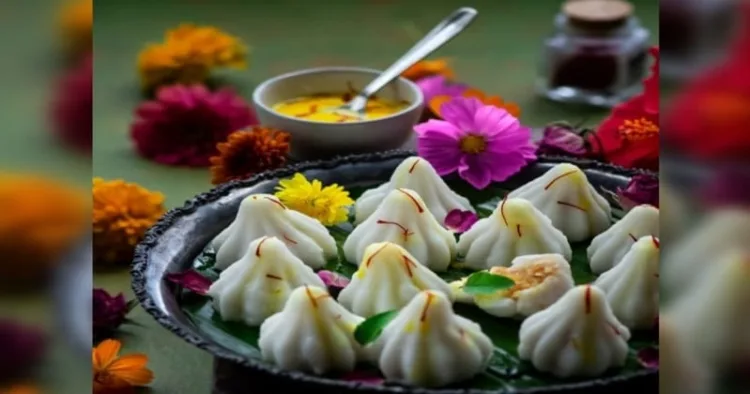Modak, a delicious Indian sweet, is cherished particularly during the sacred festival of Ganesh Chaturthi. This revered occasion is celebrated with immense enthusiasm, and there’s no better way to pay tribute to Bhagwan Ganesha than by offering him a variety of delightful modaks.
Modak is revered as the favourite sweet of the Hindu deity Ganesha, who is affectionately known as “Modakapriya” (one who loves modak) in Sanskrit. The term “modak” translates to “small part of bliss” and symbolises spiritual knowledge. During Ganesh Chaturthi, the puja typically concludes with an offering of 21 or 101 modaks to Bhagwan Ganesha. Modaks with rice flour shells are commonly preferred for this offering, though versions with wheat shells are also used.
Let us know about various popular types of modaks, each with its own distinct flavour profile and cultural significance.
Ukadiche Modak
Origin and Tradition:
Originating from Maharashtra, the ukadiche modak is the quintessential traditional choice for celebrations. With its delicate rice flour covering and a luscious jaggery and coconut filling, this modak embodies the essence of tradition and devotion.
Ingredients:
To create the perfect ukadiche modak, gather rice flour, water, grated coconut, jaggery, cardamom powder, ghee, and a pinch of salt. These ingredients come together to create a blend of flavours and textures.
Preparing the Dough:
Start by boiling water and adding a pinch of salt and ghee. Gradually mix in the rice flour to form a smooth dough. Achieving the right consistency is crucial for making pliable and soft modaks.
Flavourful Filling:
Combine grated coconut, jaggery, and cardamom powder to create a sweet and aromatic filling that adds a delightful contrast to the modak’s outer shell.
Gentle Steaming:
Steam the modaks delicately to cook the rice flour and set the filling, achieving a soft texture while preserving the rich flavours.
Elegant Finishing Touch:
Enhance the modaks with a touch of ghee or edible silver foil to add a final layer of elegance and indulgence, making them even more appealing.
Dry Fruit Modak
Indulgent Nutrition:
Elevate your modak experience with the richness of dry fruits. Combining dried figs, dates, nuts, and raisins, this modak offers a wholesome and nutritious treat, ideal for those mindful of their health.
Healthful Delight:
Packed with the goodness of figs, dates, nuts, and raisins, the Dry Fruit Modak is a guilt-free indulgence brimming with essential nutrients. It’s a treat that satisfies both your sweet tooth and nutritional needs.
No-Cook Convenience:
This easy, no-cook recipe is a time-saver! Simply blend finely chopped or ground dry fruits with a touch of ghee to create these quick and simple modaks.
Naturally Sweet:
Harness the natural sweetness of dates and figs, eliminating the need for refined sugars. This healthier alternative maintains a delightful taste without sacrificing flavour.
Customisable Texture:
Adjust the texture to your liking by leaving the dry fruits slightly chunky for added satisfaction, or pulse them for a smoother filling that’s easy to shape.
Crunchy Nuts:
Incorporate chopped almonds, cashews, and pistachios for a delightful crunch that contrasts beautifully with the soft, sweet, dried fruits.
Spice Infusion:
Enhance the flavour with a pinch of warm spices like cardamom or nutmeg, adding a layer of aromatic richness to your modaks.
Cultural Essence:
While adding a modern twist to traditional modaks, this dry fruit version preserves the essence of devotion and celebration that defines this beloved Indian sweet.
Kesari Modak
Saffron Elegance:
Infused with the rich aroma of saffron, the Kesari Modak brings a touch of royalty to your celebrations. Its vibrant orange hue symbolises prosperity and joy, making it a standout choice for festive occasions.
Garnished Delight:
A sprinkle of pistachios on top adds a delightful crunch and enhances the visual appeal of the Kesari Modak, making it not only delicious but also beautifully presented.
Cultural Reverence:
Kesari Modak is more than just a treat; it holds deep cultural significance. The saffron colour signifies purity and spirituality, making it a cherished offering during sacred and auspicious celebrations.
Artful Crafting:
Creating Kesari Modak requires a blend of gentle craftsmanship and precision. The art of moulding these modaks is as much about the aesthetic presentation as it is about the exquisite taste, resulting in a truly refined culinary creation.
Coconut Jaggery Modak
South Indian Essence:
Embrace the rustic flavors of South India with the Coconut Jaggery Modak. Combining fresh grated coconut and earthy jaggery, this modak offers a taste journey through the coastal regions.
Deep Caramel Flavour:
The jaggery imparts a rich, caramelized sweetness, balancing perfectly with the nutty flavour of coconut. This creates a harmonious and comforting sweetness in each bite.
Natural Sweetness:
Opt for a healthier sweet treat with this modak, which uses jaggery instead of refined sugar. Jaggery’s natural benefits add a unique, comforting flavour to the modak.
Textural Delight:
The shredded coconut provides a delightful chewiness, creating a satisfying contrast with the soft, tender outer layer of the modak.
Simple and Authentic:
With only a few ingredients—fresh coconut, jaggery, and rice flour—this modak is easy to prepare and brings authentic South Indian flavours right to your kitchen.
Effortless Shaping:
The coconut-jaggery mixture’s pliable consistency makes shaping the modaks into their traditional cone form a simple task, enhancing their visual appeal.
Aromatic Appeal:
As the modaks steam, they release a wonderful aroma of coconut and jaggery, filling the air with a festive fragrance that enhances the celebratory atmosphere.
In India, modak holds deep historical and cultural significance, with regional variations across the country. Known as modak in Marathi (मोदक), nevri in Konkani (नेवरी), and mandaa in Odia (ମଣ୍ଡା), it reflects diverse linguistic traditions. In Karnataka, it is called kadubu (ಕಡುಬು), while in Tamil Nadu, it is referred to as kozhukattai (கொழுக்கட்டை). In Kerala, it is known as kozhukatta (ടൊഴുക്കട്ട), and in Andhra Pradesh and Telangana, it is called jilledukayalu (జిల్లేడుకాయలు). Each name and variation highlights the rich tapestry of regional cultures and culinary practices associated with this beloved sweet.



















Comments